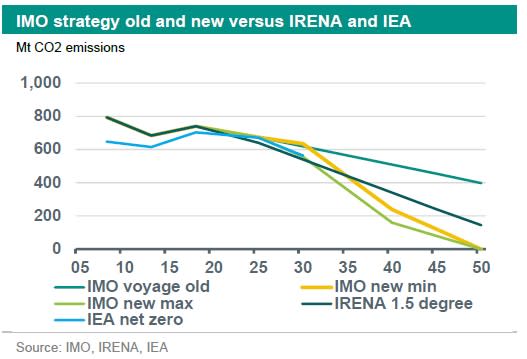New strategy to reduce GHG emissions from maritime shipping

The International Maritime Organisation (IMO) revised its strategy to bring down GHG emissions faster. The aim is to reach net-zero GHG emission by or around 2050 by reducing carbon intensity and increasing uptake zero or near-zero GHG emission technologies, fuels and/or energy sources. The new IMO pathway is ambitious compared to existing net zero benchmarks but the midterm reduction measures are still to be agreed.
International shipping is responsible for around 2% of greenhouse gas emissions
The International Maritime Organisation revised its strategy to bring down GHG emissions faster
The aim is to reach net-zero GHG emission by or around 2050 by reducing carbon intensity…
…and increasing uptake zero or near-zero GHG emission technologies, fuels and/or energy sources
Introduction
The aim is to become net zero by 2050. The shipping industry has to play a role in achieving a net zero pathway, which would limit global warming to 1.5 degrees. International shipping accounts for around 2% of global greenhouse gas emissions. The shipping industry is tied to several regulations and ambitions of a number of organizations such as the targets of the International Maritime Organization (IMO), the Poseidon principles and the European Commission’s Fit for 55. When it comes to emissions regulations, there are two key standards to consider: regulations and EU stage V. The main difference between them is that IMO regulations apply to sea-going vessels, while EU stage V diesel emissions apply to inland waterway vessels. There is another key policy drive adding to these: maritime shipping will become part of the ETS in 2024. In our Sustainaweekly of 18 April (here is the link to this report) we focussed on this. In this publication we focus on the strategy revision of the International Maritime Organization to bring down greenhouse gas emissions faster, which was published recently.
UN International Maritime Organization Strategy update
The International Maritime Organization (IMO) is the UN specialized agency responsible for the safety and security of shipping and the prevention of marine and atmospheric pollution by ships. On 7 July it revised its strategy on reduction of greenhouse gas emissions from ships. It revoked the 2018 Initial IMO GHG Strategy of 2018. It announced its new strategy, which is a continuation of the work done by the IMO to address greenhouse gas emissions from international shipping. The strategy is aimed at enhancing IMO’s contribution to global efforts addressing greenhouse gas emissions from international shipping.
The strategy identifies levels of ambition (more on this below) for the international shipping sector noting that technical innovation and the global introduction and availability of zero or near-zero GHG emission technologies, fuels and/or energy sources for international shipping will be integral part to achieving the overall level of ambition. The levels of ambitions and indicative checkpoints should be taken into account the well-to-wake GHG emissions of marine fuels as addressed in the guidelines on lifecycle GHG intensity of marine fuels (LCA guidelines). Below we set out more details on the well-to-wake basis and LCA guidelines. The regulations will be mandatory for all ships. Vessels will not get any exceptions based on a flag they are registered under.
Life cycle assessment
To reduce emissions it is crucial to have a good understanding of what the emissions are, the number of emissions emitted and when they are emitted. In its previous IMO strategy international shipping measured CO2 emissions via the tank-to-propeller approach. In this approach the total CO2 emissions from combustion on board of a ship and potential leakage are measured. In its strategy IMO changed to a new approach. The IMO has adopted a lifecycle assessment (LCA). The lifecycle assessment method refers to the assessment of greenhouse gas emissions from the fuel production to the end-use by a ship or well-to-wake approach; it results from the combination of a well-to-tank part (from primary production to carriage of the fuel in a ship's tank, also known as upstream emissions) and a tank-to-wake (or tank-to-propeller) part (from the ship's fuel tank to the exhaust, also known as downstream emissions). So it is a calculation method. It also defines a fuel life cycle label that specifies the information relevant for the life cycle assessment. The graph below is the visual overview of the different approaches.

New ambition levels and intermediate levels
What are the new ambition levels and indicative or intermediate targets? Below we set out the key areas:
Carbon intensity of the ship to decline through further improvement of the energy efficiency for new ships
To reduce CO2 emissions per transport work (this is distance sailed x capacity) as an average across international shipping by at least 40% by 2030 compared to 2008.
Uptake of zero or near-zero GHG emission technologies, fuels and/or energy sources to represent at least 5% and striving for 10% of the energy used by international shipping by 2030
To reduce the total annual GHG emissions from international shipping by at least 20%, striving for 30% by 2030 compared to 2008 (indicative checkpoint)
To reduce the total annual GHG emissions from international shipping by at least 70%, striving for 80% by 2040 compared to 2008 (indicative checkpoint)
GHG emissions to peak as soon as possible and to reach net-zero GHG emissions by or around 2050 taking into account different national circumstances.
Timelines
The ambition levels translate into specific measures of how to reach net-zero by or around 2050. There are short-term, mid-term and long-term reduction measures. The short-term strategy reduction measures are the measures finalized and agreed by the committee between 2018 and 2023. This is a review of the mandatory goal-based technical and operational measures to reduce carbon intensity of international shipping. They need to be completed by January 2026.
The basket of mid-term reduction measures should be finalised and agreed by the Committee by 2025. These should both comprise a technical element and an economic element. A technical element means a goal-based marine fuel standard regulating the phased reduction of the marine fuel’s GHG intensity. The economic element is on the basis of a maritime GHG emissions pricing mechanism. This could be in line with EU ETS. The reduction target should take into account the Well-to-Wake GHG emissions of marine fuels. These measures enter into force in 2027.
Other candidate mid-term GHG reduction measures could be finalized and agreed by the Committee between 2023 and 2030. Possible long-term measures could be measures finalized and agreed by the Committee beyond 2030 to be developed as part of the 2028 review of the IMO strategy.
Maritime shipping pathways
With the review of its strategy, the IMO has also significantly changed its reduction pathway. Previously the strategy aimed at a 50% reduction in greenhouse gasses by 2050 and to be net zero in 2100. The revised strategy is far more ambitious. It aims to be net-zero 50 years earlier in a hard to abate sector. The new pathway is close to the IEA net zero pathway and even more ambitious than the IRENA 1.5-degree pathway. The graph below shows the old and new IMO pathways (voyage-based calculation method), the IRENA 1.5-degree pathway and IEA net zero.

With this ambitious pathway the IMO assumes that technical innovation and the global introduction and availability of zero or near-zero GHG emission technologies, fuels and/or energy sources for international shipping will be integral part to achieving the overall level of ambition. This is exactly where the bottlenecks are. The future energy carrier has still to be decided. Most fuels have lower energy density compared to the maritime fuels used currently. This means more storage and alterations to the ships to deal with the extra weight and safety of these other fuels would be vital. Engines need to be adjusted accordingly as well. The life of a maritime ship is on average 25 years so the risk of stranded assets is high. Even if the future energy carrier has been decided, there also needs to be enough production. The marginal abatement costs of the possible future energy carriers are still high. So the uptake of zero-or near-zero GHG emission technologies, fuels and or energy sources of at least 5% by 2030 may be quite a challenge.
Conclusion
International shipping is responsible for 2% of the global greenhouse gas emissions. The IMO has revised its strategy to bring down greenhouse gas emissions faster. It aims to be net zero by or close to 2050 in a hard to abate sector. It has also set some indicative targets for 2030 and 2040. In addition the IMO has as target that the uptake of zero or near-zero GHG emission technologies, fuels and/or energy sources to represent at least 5% and striving for 10% of the energy used by international shipping by 2030. This comes at a time that the marginal abatement costs of these technologies/fuels are still very high and the fuels are not produced in large quantities. The new IMO pathway is roughly in line with IEA net-zero (up to 2030) but more ambitious than the IRENA 1.5-degree pathway. Overall we think the new IMO pathway is very ambitious and may not take into account the challenges. Changing the energy carrier is crucial and with that comes other challenges such as safety using a new energy carrier, adjusting design of the ship, and the engine readiness of using a new fuel. So the path to decarbonize shipping is likely to be a long one.
This article is part of the SustainaWeekly of 17 July 2023
